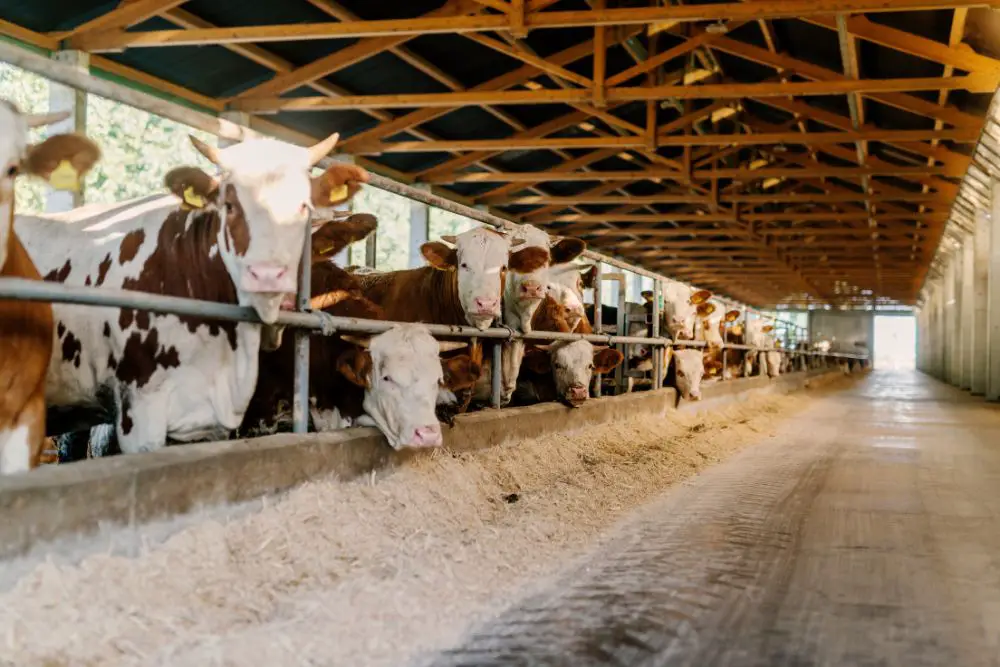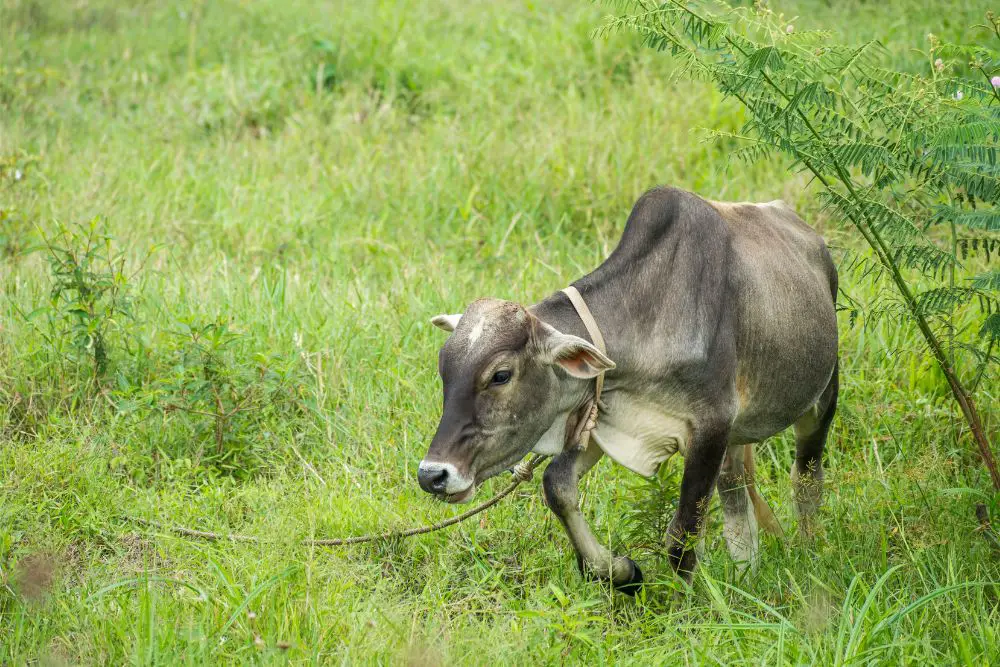Cows have natural lifespans of around 20 years, but most cattle never even get close to dying of old age. Dairy cattle are culled from the age of 3 to 6 years, beef cattle from 2 to 3 years, while veal cattle are slaughtered at just 6 to 9 months old.
According to The Guinness World Records, Big Bertha, a Dremon from Kerry, Ireland, reached an age of 48 years and 9 months! In modern agriculture, very few cows get to live 1/10th of that.
Table of Contents
Average Lifespans of Cattle
Dairy farms cull their female cows and heifers at 6 years of age or when they no longer produce enough milk to be economically viable. However, their meat is somewhat low-grade as some dairy farmers are not big on animal welfare and put their cattle through a highly rigorous life.
Constant movement between pens, overcrowding, and co-existence of calves and cows in dairy herds are some negative features of life as a dairy cow. These harsh conditions mean that many cows can suffer from ailments such as lameness towards the end of their life.
All this stress throughout the cow’s life causes diseases like mastitis and releases hormones that reduce the quality of the meat. Consequently, beef from slaughtered dairy industry cattle is not always fit for human consumption and finds its way into pet food or ground beef products, such as hamburgers or sausages.
Meanwhile, beef cattle typically go to the slaughterhouse from 2 years old. Ranchers move their cattle to feedlots at about 6 months to a year, where they will reach market weight and be slaughtered at about 2 to 3 years of age.

Pasture-raised cattle never see a feedlot and can live up to 5 years before slaughter, but they are in the minority. About 80 percent of American beef cattle are finished in feedlots.
Male calves born to dairy cows go to slaughter about 1 year after birth because the farm has no use for them other than as a commodity. If a farmer wants veal calves, they will reach live 6 months or less. A female calf that doesn’t produce enough milk to be profitable will also be slaughtered.
Veal calves are removed from their mothers after just a few days and put alone into tiny cages known as veal crates. The confined space restricts muscle growth and causes the tender, gray meat we associate with veal, with slaughters starting at approximately 5 months of age. Around 700,000 calves go to slaughter every year in the United States.
Longest Living Cow Breeds
Chianina
Chianina (pronounced key-a-nina) is an Italian breed that can live 20 or more years if used as a draft animal. It is the tallest and heaviest breed of cattle in the world.
The fast-growing calves are a fawn color, although adult cows and bulls are white with short, stubby horns. Although Chianina cows have small udders, they don’t have high milk production.
Their beef is pinkish-red and contains more protein but less fat and cholesterol than other breeds.
Jersey
When a homesteader talks about the life span of their cattle, they add the length of time the cow produces milk. Jersey cows produce high-quality milk for up to 4 years.
Normal cattle can reach up to 20 years old, but a Jersey cow can live even longer, with some exceeding their 25th birthdays, and one even reaching 37!
Holstein-Friesian
While some cows may live considerably longer, the average productive life of a Holstein is 6 years. What sets them apart, however, is their incredible milk-producing yield. A Holstein-Friesian cow in Wisconsin, USA, produced an average of nearly 20 gallons of milk daily.
However, an average Friesian-Holstein cow will produce just over four gallons a day.
Brown Swiss
Longevity is a characteristic feature of the Brown Swiss. While they tend to mature later than other breeds, cows reach their peak during the fifth or subsequent lactations. Some breeds have difficulty reaching so many, but the strength of the Brown Swiss allows them to lead long, productive lives.
Dairy Shorthorn
Shorthorns display sound physical characteristics, good breeding, and longevity, claiming the saying “the breed that has it all.”
Most Dairy Shorthorns achieve at least five lactations, with reports of several examples producing over 2,600 gallons per lactation at over 10 years of age.
Miniature Cows
Miniature cows originated from scientific breeding programs and are a popular choice for domestic farms. Their small stature means they are cheaper to maintain as they eat less and need less space to live.
Miniature cows live up to 18 years old, which is fairly close to the lifespan of a normal-sized cow if it was allowed to complete it. They usually live a full lifespan due to most owners being homesteaders using them for milk production or being used as pets.
A good example is the Australian Lowline:
| Average height | 3.5 feet at the shoulder |
| Average cow weight | 700 pounds |
| Average bull weight | 880 pounds |
| Fertility | N/A |
A miniature cow may be the ideal choice for a domestic farm, producing up to two gallons of milk per day, and the meat is of decent quality too. Miniature cattle have good temperaments, being easy to handle and breed well.
The Dexter another small heritage breed worth a mention:
| Average height | 3.5 feet at the shoulder |
| Average cow weight | 650 pounds |
| Average bull weight | 1,000 pounds |
| Fertility | 14 to 20 years |
Honorable Mentions
Ayrshires, Brown-Swiss, Guernseys, and Holsteins can calve into their eighth year. Kerrys and Dutch Belted cows can still calve into their 14th or 15th year. The Sahiwal can reproduce even at 20.
Nearly 25 percent of Montbéliardes can complete five lactations and there are records of Estonian Reds achieving the seventh lactation.
Other breeds noted for their long-lasting milk production and longer lifespans are the Girolando, the Illawarra, the Irish Moiled, the Meuse Rhine Issel, and the Milking Devon.
How to Help Your Cow Live Longer
Cows require many and varied resources to survive because of their size. They need extensive, high-quality pasture and somewhere to shelter from the elements.
Cows are far more responsive to good hygienic conditions than we assume, and will thrive if provided with clean water, a well-maintained environment with protection from the weather and personal attention on occasions.

If you can provide all these things, your cow will live longer and have better health, giving you more plentiful and higher-grade milk or beef, leading to higher yields and a more profitable farming business.
Provide Plenty of Food to Graze
Ensure your pasture can support your dairy cows as they eat around 30 pounds daily. They will also need around 5 pounds a day of supplementary feed, such as hay, corn, or barley, even if they have plenty of grass to graze on.
Store your grain and hay in a clean, dry place free of dirt. If this looks even slightly rotten, smells musty, or you see what you think are rat or mouse droppings, do NOT feed it to your cow.
A cow is a ruminant, i.e., it has a single cloven hoof, and its stomach has four different sections. Consequently, they spend long periods eating grass and “chewing the cud” – masticating partly-digested food before finally swallowing it.
Ensure your pasture is peaceful and away from noise or crowds so the cow is relaxed enough to chew the cud without disruption or stress. Stress-free cows produce the best and most bountiful milk.
Keeping the grass short avoids ticks who are one of a cow’s worst enemies. General insect control is important a domestic farmer. Swarms of mosquitoes, for example, can disrupt a cow’s feeding and rumination, leading to reduced milk quality and output.
Supply Ample Housing and Space
It isn’t necessary to spend a fortune on your cow’s stall or barn. A reasonably simple structure will suffice with a leak-free roof and with minimal draughts.
Cows love to roam freely, requiring about two acres not to feel confined with sturdy fences. They will not hesitate to test the resistance of your electric fences to wander a little further. You only have to try and catch an escaped cow once to know that you’ll never want to do it again!
Allow Plenty of Clean Water
A cow can quite easily drink around 30 gallons of water a day, and more in hot weather and when a female has a suckling calf. Cows can be pretty fussy and don’t like water that is dirty, too cold, or too hot, so provide a source of cool, clean water that is easily accessible.
A pond is always a good option. However, keep it clear of vegetation and ensure it has a proper cycle of fresh water in and older water out. You don’t want a potential breeding ground for mosquitoes!
Beware of Insect Infections
Because of their internal anatomy and relatively inefficient physical features around their rear quarters, cows and their excrement are constant companions.
Their complicated digestive system produces a lot of very moist feces, and defecation in a cow is a messy process. Their rectal orifice is too vertical and not inclined downwards. There is also a large, swishing tail in the way that accumulates and spreads any undeposited fecal matter.
Consequently, apart from the numerous “cow pies” or “cow pancakes” they produce, a cow’s rump is often plastered with excreta. This unfortunate combination of circumstances means flies love being around a cow as they seek a place to lay their eggs, and are also rather fond of feeding on a cow’s blood.
Flies spread disease and irritation, which disrupt regular grazing routines and milk yield. Be especially vigilant also for mites, ticks, and lice. Some flies and ticks, in particular, can transmit anaplasmosis, a blood disease responsible for miscarriages and even death in cows.
You can drastically reduce the chances of insect-borne diseases by vigilant and frequent application of sprays and insecticides. Remember that unhealthy or uncared-for animals do not have the same resistance to immunity as a healthy, well-cared-for cow.
Keeping your cow’s living areas in order is paramount. As mentioned previously, her stall must be clean and dry, and she should have a safe and healthy external environment.
Hoof Trimming
Cows’ hooves also require trimming every few months. Only a professional exponent of bovine footcare should carry out hoof treatments as these experts will have the skills, tools, and equipment to cut your cow’s hooves properly.
Treating hooves can be stressful and painful for a cow, so a cattle chute or cattle race is typically used. These apparatus are narrow metal-barred holding devices that immobilize the cow allowing the vet or footcare professional to work unimpeded and without fear of being kicked, butted, or shoved over.
